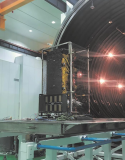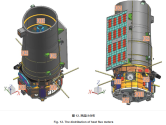You are using an out of date browser. It may not display this or other websites correctly.
You should upgrade or use an alternative browser.
You should upgrade or use an alternative browser.
News on China's scientific and technological development.
- Thread starter Quickie
- Start date
supercat
Colonel
New carbon-free method for hydrogen production:
Another new catalyst paves the way for cost-effective production of green hydrogen.
The novel catalyst is the result of a 10-year research:Traditional methods of hydrogen production through ethanol reforming typically require high temperatures ranging from 300 to 600 degrees Celsius, consuming vast amounts of energy and generating significant CO2 emissions. The new process, however, uses a novel catalyst to produce hydrogen by reacting bioethanol -- derived from agricultural and forestry waste -- with water at a temperature of only 270 degrees Celsius.
This reaction is enabled by a catalyst containing a high density of atomic Pt1 and Ir1 species supported on a reactive alpha-molybdenum carbide substrate
Thermal catalytic reforming for hydrogen production with zero CO2 emission
Another new catalyst paves the way for cost-effective production of green hydrogen.
The meticulous design ensured the optimal embedding of iridium oxide within the cerium oxide support and yielded a highly stable and efficient catalyst. Rigorous testing under the water electrolyzer technology operating conditions for an extended period of 6,000 hours demonstrated the catalyst's exceptional durability. It exhibited minimal voltage decay and maintained high activity, surpassing international performance standards.
Ultrastable supported oxygen evolution electrocatalyst formed by ripening-induced embedding
To be fair the a lot of the top-cited US scientists are probably also ethnic Chinese.
wow from 2010 till 2024, i can still remember how in the 2000s and early 2010s you have a lot of western press articles about how Chinese scientist were cheating on science papers.
Onboard integrated high-resolution microsatellite precision thermal control
In recent years, there has been an explosive development of micro satellites, and many high-performance micro optical remote sensing satellites have been launched. Integrated design of satellite platform and payload is a method to reduce weight and improve performance. rise of CCDs is less than 1 ℃/min during imaging. Firstly, the overall layout of the satellite is presented, the orbital heat flux under different conditions has been analyzed. Due to the fact that the - Z plate of the satellite faces the cold space, the - Z plate absorbs the minimum space heat flux and has the strongest heat dissipation capacity. Therefore, the bottom plate in - Zdirection is selected as the heat dissipation window for the entire satellite. Electronic components are designed reasonably to achieve temperature equalization. The maximum power of electronic components is 252 W. Reasonably set up heat dissipation channels to ensure that the temperature of electronic components will not be too high,which will affect its reliability and payload temperature stability. 0.01 ℃. And the temperature control of the secondary mirror is achieved through the use of radiation heating, which makes the temperature fluctuation of the mirror less than ±0.05 ℃. The thickness of the pyrolytic graphite sheets is 1.5 mm and its thermal conductivity is 900 W/(m·K). conductivity of 10 mm carbon fiber truss can be increased from 10 W/(m·K) to 126 W/(m·K) by using the 1.5 mm pyrolytic graphite sheets. In order to reduce the temperature changes of CCDs during imaging, phase change materials and thermal straps are used inside the satellite. Thermal straps can maintain thermal contact while allowing for positional changes of focal components. The thermal resistance of thermal straps is less than 1 ℃/W. When CCDs start working,heat is first transferred to the phase change material. Phase change materials absorb heat and melt, but the temperature remains relatively constant during the process, which reduces the temperature fluctuations of CCDs. After the CCDs work, heat is transferred out through thermal straps, and the phase change material solidifies again. Then, the finite element thermal analysis model is established and the simulation calculation is completed. According to the analysis results, the temperature gradient among the mirrors and the truss is less than 1 ℃, with temperature fluctuations within ±0.1 ℃. And the temperature of the avionics is within the required range,verifying the correctness of the thermal design. Finally, the thermal balance test of the satellite was carried out and the flight data of the thermal control system has also been collected. The results of thermal test and the in orbit temperature show that the temperature of the avionics ranges from 0 to 35 ℃, the temperature of the optical payload ranges from 19.5 to 20.5 ℃, and the temperature fluctuation is within ±0.05 ℃. The CCDs temperature ranges from 15 to 20 ℃, and the temperature rise during operation is less than 0.5 ℃/min, which meets the temperature control target and imaging requirements of the satellite, and verifies that the thermal design is reasonable and feasible.


Now u say that, i suddenly remembered a video of a US guy (not sure of prof or scientist) having a seminar(?) In a HK university talkig abt China Patents/Research, being number 1 in amount of patents, what he claims and telling HK univeristy students that time is that those are low quality or just copy w few modification etc. Not sure how it affected HK university students view of CN mainland that time. It was a video long before covid in youtube. Cant remember the name. Now seem they cant claim such reason anymore tho...wow from 2010 till 2024, i can still remember how in the 2000s and early 2010s you have a lot of western press articles about how Chinese scientist were cheating on science papers.
As if American patents are better:Now u say that, i suddenly remembered a video of a US guy (not sure of prof or scientist) having a seminar(?) In a HK university talkig abt China Patents/Research, being number 1 in amount of patents, what he claims and telling HK univeristy students that time is that those are low quality or just copy w few modification etc. Not sure how it affected HK university students view of CN mainland that time. It was a video long before covid in youtube. Cant remember the name. Now seem they cant claim such reason anymore tho...

